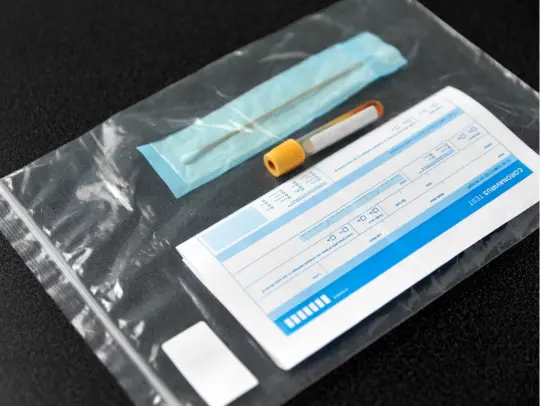
Nurse Practitioner Clarissa - Beyond the Bedroom: Why ED Could Be a Warning Sign of Something Much More Serious
Beyond the Bedroom: Why ED Could Be a Warning Sign of Something Much More Serious
Erectile dysfunction (ED) is often viewed simply as a bedroom problem—an inconvenience that can be fixed with a little blue pill. But what many men don't realize is that their struggle to maintain an erection might actually be an early warning sign of a much more dangerous condition developing throughout their body. Today, we'll explore a critical case study that reveals the hidden connection between ED and potentially life-threatening cardiovascular disease.
The Patient's Story
A man visits the clinic seeking help for erectile dysfunction, hoping for a quick solution like testosterone supplements or Viagra. His ED has been progressively worsening, affecting his confidence and relationship. He's already tried several natural approaches to boost his testosterone levels:
- Regular exercise and weight loss
- Vitamin D supplementation
- Improved sleep hygiene
- Dietary adjustments
While these efforts yielded minor improvements, his ED persisted. What he doesn't realize is that his erectile dysfunction is actually a symptom of a serious underlying problem that has been silently developing for over 15 years.
Understanding the Real Problem: It's About Blood Flow
The primary cause of this patient's erectile dysfunction isn't low testosterone—it's reduced blood flow to his genital area. Without sufficient blood supply, his penis simply cannot achieve the necessary firmness for penetration, resulting in a flaccid state during attempted intercourse.
But why is his blood flow compromised? To understand this, we need to examine what's happening inside his arteries.
The Anatomy of Healthy Arteries
Arteries are not simple tubes—they're complex, living structures made up of multiple layers of specialized tissue:
- Endothelium: The smooth inner lining that allows blood to flow easily
- Smooth muscle layer: A thick middle layer that contracts and relaxes to regulate blood flow
- Adventitia: The protective outer layer
In a healthy individual, these layers work in harmony. The inside of the artery remains smooth, allowing blood to flow freely to all organs—including the penis.
The Silent Progression: How Arterial Disease Develops
What makes vascular disease so dangerous is that it develops slowly and silently over decades, often with no noticeable symptoms until significant damage has occurred. Let's examine the stages of this process as they likely occurred in our patient.
The first signs of trouble began with small fatty deposits forming beneath the endothelium (inner lining) of the patient's arteries. These initial deposits:
- Showed no outward symptoms
- Would only be detectable through specialized testing
- Began the process of arterial narrowing
At this stage, the patient would have felt completely normal, with no indication of the developing condition.
As the condition progressed, routine blood work would have revealed elevated cholesterol levels. This indicated that:
- Cholesterol was spending too much time in the bloodstream (high "residency time")
- Instead of efficiently delivering fuel and returning to the liver, cholesterol was lingering in the blood
- This excess cholesterol was gradually building up in arterial walls
Even at this stage, the patient likely experienced no symptoms that would connect these blood test results to future erectile problems.
As fatty deposits continued to accumulate, the body recognized this as damage and launched an inflammatory response:
- White blood cells attempted to "clean up" the fatty deposits
- This created inflammation in the arterial walls
- The affected areas would have been tender and inflamed if they could be touched
- Calcium deposits began to form, creating the first potentially detectable signs through specialized imaging
By this point, the disease had been developing for at least five years, yet the patient remained unaware of the impending consequences.
Now we arrive at the patient's current state. The arterial walls have become significantly thickened and scarred due to years of accumulating:
- Fatty deposits
- Inflammatory cells
- Calcium deposits
- Scar tissue
While blood flow through the penile arteries remains partially functional, it's significantly reduced—explaining his erectile difficulties. But the true danger lies in what could happen next.
The Imminent Danger: Beyond Erectile Dysfunction
The most alarming aspect of this case isn't the patient's erectile dysfunction—it's what's likely to happen next. The diseased tissue in his arterial walls is on the verge of rupturing, similar to a pimple erupting through the skin.
When this plaque ruptures into the bloodstream, it triggers an immediate emergency response from the body:
- Platelets rush to the site and begin to form a clot
- Fibrinogen creates a mesh to stabilize the clot
- Blood flow begins to slow and eventually may stop completely
Depending on where this blockage occurs, the consequences can be life-threatening:
- In a coronary artery: Heart attack
- In a cerebral artery: Stroke
- In penile arteries: Erectile dysfunction progressing to complete impotence
What makes this particularly dangerous is that the patient is completely unaware of this imminent risk. He's focused on treating ED as an isolated issue, not recognizing it as a symptom of systemic vascular disease.
The Critical Connection: ED as an Early Warning System
What's particularly significant about erectile dysfunction is that it often precedes more serious cardiovascular events. The penile arteries are smaller than coronary arteries (1-2mm vs. 3-4mm in diameter), so they show the effects of vascular disease earlier. In essence, ED can serve as a 3-5 year advance warning of potential heart problems.
Looking Beyond Testosterone: The Real Culprit
While this patient believes his problem is related to testosterone, the evidence points to a different hormone playing a pivotal role: insulin.
Elevated insulin levels and insulin resistance are strongly associated with the development of atherosclerosis (arterial plaque buildup). When assessing cardiovascular risk, five key predictors should be evaluated:
| Risk Factor | Concerning Level | Connection to Vascular Health |
|---|---|---|
| Triglycerides | =150 mg/dL | Indicates excess fat in bloodstream |
| HDL Cholesterol | =40 mg/dL (men) | Lower levels mean reduced capacity to remove arterial plaque |
| Blood Pressure | =130/85 mmHg | Increases stress on arterial walls |
| Waist Circumference | =40 inches (men) | Indicates visceral fat, which drives inflammation |
| Fasting Blood Sugar | =100 mg/dL | Signals insulin resistance |
Having three or more of these risk factors not only indicates metabolic syndrome but substantially increases the risk of a cardiovascular event within the next decade.
The Comprehensive Approach to Treatment
Addressing erectile dysfunction effectively requires looking beyond symptomatic treatments like Viagra, which may temporarily improve blood flow but don't address the underlying vascular disease. A comprehensive approach includes:
- Complete cardiovascular risk assessment: Including advanced lipid testing and inflammatory markers
- Dietary intervention: Focusing on reducing refined carbohydrates and inflammatory foods
- Targeted exercise: Both resistance and cardiovascular training
- Stress management: Chronic stress drives inflammation and vascular damage
- Medical therapy: May include statins, blood pressure medications, or metformin based on individual risk factors
When these underlying factors are addressed, many men experience improvements not only in erectile function but in overall health and well-being.

Nitric Oxide
Nitric Oxide Blood Flow Support
Mens Health Supplement FDA-approved Nitric Oxide Blood Flow Support ensuring high-quality and safe supplement for your erectile dysfunction treatment.Regular Price $49.00
Your Price Buy Now!
Coupon automatically added to your cart
Nitric oxide is an inherently occurring molecule located in the body that helps open up veins and arteries. It causes relaxation of the smooth muscles in the penis, which results in an increase in blood flow and ultimately leads to the occurrence of an erection.
Supports Healthy Blood Flow: Energy, Libido Enhancer and Circulation Support.
Nitric Oxide Daily: Men Over 70 or Declined Prescription ED Medications.
Nitric Oxide and Penis Pump: Nitric Oxide with Penis Pump Use May Help Limit ED.
The Critical Takeaway: ED as a Cardiovascular Red Flag
The case of this patient illustrates a crucial message: erectile dysfunction should never be dismissed as merely a sexual health issue or an inevitable consequence of aging. Instead, it should be viewed as a potential early warning sign of cardiovascular disease that warrants comprehensive evaluation.
For men experiencing ED, particularly those over 40 or with other risk factors such as high blood pressure, diabetes, or obesity, a thorough cardiovascular workup may be life-saving. The difficulty achieving an erection today could be the body's way of warning about a potential heart attack or stroke tomorrow.
Important Warning Signs That Require Immediate Attention:
- ED that develops suddenly, especially in younger men
- ED accompanied by chest pain, shortness of breath, or unusual fatigue
- ED that coincides with other cardiovascular symptoms like leg pain during walking
- ED that doesn't respond to first-line treatments like PDE5 inhibitors (Viagra, Cialis)
These patterns suggest significant vascular compromise that may indicate imminent cardiovascular risk.
By recognizing erectile dysfunction as potentially more than just a sexual issue, men have the opportunity to address serious health concerns years before they might otherwise cause life-threatening complications. What begins as a concern in the bedroom could be the warning that saves a life.
If you're experiencing symptoms of erectile dysfunction, especially if you have other risk factors for heart disease, don't hesitate to seek comprehensive medical evaluation. There's much more at stake than just your sex life—it could be your life itself.



























































